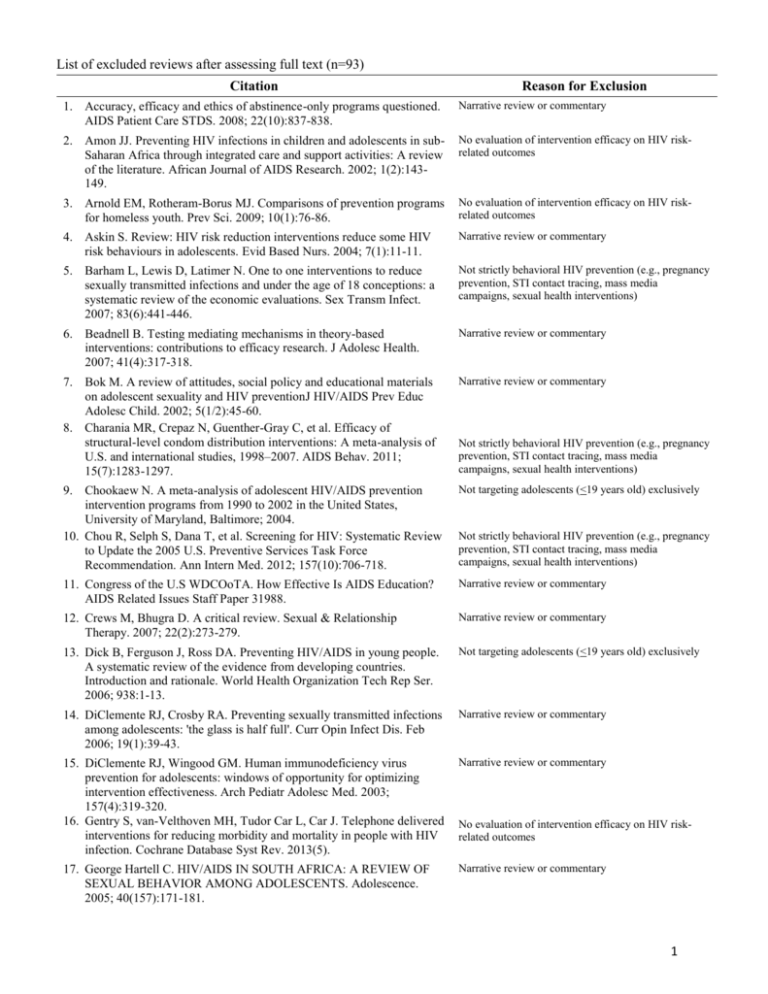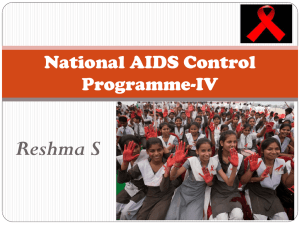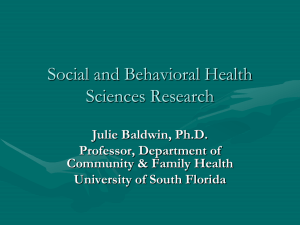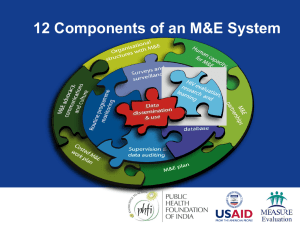List of excluded reviews after assessing full text (n=93) Citation
advertisement

List of excluded reviews after assessing full text (n=93) Citation Reason for Exclusion 1. Accuracy, efficacy and ethics of abstinence-only programs questioned. AIDS Patient Care STDS. 2008; 22(10):837-838. Narrative review or commentary 2. Amon JJ. Preventing HIV infections in children and adolescents in subSaharan Africa through integrated care and support activities: A review of the literature. African Journal of AIDS Research. 2002; 1(2):143149. No evaluation of intervention efficacy on HIV riskrelated outcomes 3. Arnold EM, Rotheram-Borus MJ. Comparisons of prevention programs for homeless youth. Prev Sci. 2009; 10(1):76-86. No evaluation of intervention efficacy on HIV riskrelated outcomes 4. Askin S. Review: HIV risk reduction interventions reduce some HIV risk behaviours in adolescents. Evid Based Nurs. 2004; 7(1):11-11. Narrative review or commentary 5. Barham L, Lewis D, Latimer N. One to one interventions to reduce sexually transmitted infections and under the age of 18 conceptions: a systematic review of the economic evaluations. Sex Transm Infect. 2007; 83(6):441-446. Not strictly behavioral HIV prevention (e.g., pregnancy prevention, STI contact tracing, mass media campaigns, sexual health interventions) 6. Beadnell B. Testing mediating mechanisms in theory-based interventions: contributions to efficacy research. J Adolesc Health. 2007; 41(4):317-318. Narrative review or commentary 7. Bok M. A review of attitudes, social policy and educational materials on adolescent sexuality and HIV preventionJ HIV/AIDS Prev Educ Adolesc Child. 2002; 5(1/2):45-60. 8. Charania MR, Crepaz N, Guenther-Gray C, et al. Efficacy of structural-level condom distribution interventions: A meta-analysis of U.S. and international studies, 1998–2007. AIDS Behav. 2011; 15(7):1283-1297. Narrative review or commentary 9. Chookaew N. A meta-analysis of adolescent HIV/AIDS prevention intervention programs from 1990 to 2002 in the United States, University of Maryland, Baltimore; 2004. 10. Chou R, Selph S, Dana T, et al. Screening for HIV: Systematic Review to Update the 2005 U.S. Preventive Services Task Force Recommendation. Ann Intern Med. 2012; 157(10):706-718. Not targeting adolescents (<19 years old) exclusively 11. Congress of the U.S WDCOoTA. How Effective Is AIDS Education? AIDS Related Issues Staff Paper 31988. Narrative review or commentary 12. Crews M, Bhugra D. A critical review. Sexual & Relationship Therapy. 2007; 22(2):273-279. Narrative review or commentary 13. Dick B, Ferguson J, Ross DA. Preventing HIV/AIDS in young people. A systematic review of the evidence from developing countries. Introduction and rationale. World Health Organization Tech Rep Ser. 2006; 938:1-13. Not targeting adolescents (<19 years old) exclusively 14. DiClemente RJ, Crosby RA. Preventing sexually transmitted infections among adolescents: 'the glass is half full'. Curr Opin Infect Dis. Feb 2006; 19(1):39-43. Narrative review or commentary 15. DiClemente RJ, Wingood GM. Human immunodeficiency virus prevention for adolescents: windows of opportunity for optimizing intervention effectiveness. Arch Pediatr Adolesc Med. 2003; 157(4):319-320. 16. Gentry S, van-Velthoven MH, Tudor Car L, Car J. Telephone delivered interventions for reducing morbidity and mortality in people with HIV infection. Cochrane Database Syst Rev. 2013(5). Narrative review or commentary 17. George Hartell C. HIV/AIDS IN SOUTH AFRICA: A REVIEW OF SEXUAL BEHAVIOR AMONG ADOLESCENTS. Adolescence. 2005; 40(157):171-181. Narrative review or commentary Not strictly behavioral HIV prevention (e.g., pregnancy prevention, STI contact tracing, mass media campaigns, sexual health interventions) Not strictly behavioral HIV prevention (e.g., pregnancy prevention, STI contact tracing, mass media campaigns, sexual health interventions) No evaluation of intervention efficacy on HIV riskrelated outcomes 1 Citation Reason for Exclusion 18. Grunseit AC, Aggleton P. Lessons learned: An update on the published literature concerning the impact of HIV and sexuality education for young people. Health Educ. 1998; 98(2):45-54. 19. Harper GW, Lemos D, Velcoff J, Benjamin JG. Empirically based sexual risk reduction interventions for university and college students. In: McAnulty RD, ed. Sex in college: The things they don't write home about. Santa Barbara, CA US: Praeger/ABC-CLIO; 2012:221-241. Not strictly behavioral HIV prevention (e.g., pregnancy prevention, STI contact tracing, mass media campaigns, sexual health interventions) 20. Harrison A, Newell ML, Imrie J, Hoddinott G. HIV prevention for South African youth: which interventions work? A systematic review of current evidence. BMC Public Health. 2010; 10:102. Not targeting adolescents (<19 years old) exclusively 21. Hartell CG. The Status of HIV/AIDS and Education Research Among Adolescents in South Africa. Int J Adolesc Youth. 2003; 11(2):113133. No evaluation of intervention efficacy on HIV riskrelated outcomes 22. Holtgrave DR, Qualls NL, Curran JW, Valdiserri RO, Guinan ME, Parra WC. An overview of the effectiveness and efficiency of HIV prevention programs. Public Health Rep. 1995; 110(2):134-146. Narrative review or commentary 23. Jacobs DB. HIV prevention with adolescents: what works and why. US, ProQuest Information & Learning; 1997. Narrative review or commentary 24. Jemmott JB, III, Jemmott LS. HIV behavioral interventions for adolescents in community settings. In: Peterson JL, DiClemente RJ, eds. Handbook of HIV prevention. Dordrecht Netherlands: Kluwer Academic Publishers; 2000:103-127. Not targeting adolescents (<19 years old) exclusively 25. Jemmott JB, III, Jemmott LS. Strategies to reduce the risk of HIV infection, sexually transmitted diseases, and pregnancy among African American adolescents. In: Resnick RJ, Rozensky RH, eds. Health psychology through the life span: Practice and research opportunities. Washington, DC US: American Psychological Association; 1996:395422. Not strictly behavioral HIV prevention (e.g., pregnancy prevention, STI contact tracing, mass media campaigns, sexual health interventions) 26. Johnson BT, Carey MP, Marsh KL, Levin KD, Scott-Sheldon LA. Interventions to reduce sexual risk for the human immunodeficiency virus in adolescents, 1985-2000: a research synthesis. Arch Pediatr Adolesc Med. 2003; 157(4):381-388. Duplicate/updated publication 27. Kang M, Skinner R, Usherwood T. Interventions for young people in Australia to reduce HIV and sexually transmissible infections: a systematic review. Sex Health. 2010; 7(2):107-128. Not strictly behavioral HIV prevention (e.g., pregnancy prevention, STI contact tracing, mass media campaigns, sexual health interventions) 28. Kaplan C. Review: behavioural counselling reduces sexually transmitted infections in adults and adolescents. Evid Based Nurs. 2009; 12(2):46-46. Narrative review or commentary 29. Kim CC, Rector R, Heritage F. Evidence on the Effectiveness of Abstinence Education: An Update. No. 2372: Heritage Foundation; 2010. Narrative review or commentary 30. Kim CR, Free C. Recent evaluations of the peer-led approach in adolescent sexual health education: a systematic review. Perspect Sex Reprod Health. 2008; 40(3):144-151. Not strictly behavioral HIV prevention (e.g., pregnancy prevention, STI contact tracing, mass media campaigns, sexual health interventions) 31. Kirby D, Crosby RA, Santelli JS, DiClemente RJ. Interventions to prevent pregnancy and sexually transmitted diseases, including HIV infection. In: DiClemente RJ, Santelli JS, Crosby RA, eds. Adolescent health: Understanding and preventing risk behaviors. San Francisco, CA US: Jossey-Bass; 2009:303-335. Not strictly behavioral HIV prevention (e.g., pregnancy prevention, STI contact tracing, mass media campaigns, sexual health interventions) 32. Kirby D, Obasi A, Laris BA. The effectiveness of sex education and HIV education interventions in schools in developing countries. World Health Organ Tech Rep Ser. 2006; 938:103-150. Not strictly behavioral HIV prevention (e.g., pregnancy prevention, STI contact tracing, mass media campaigns, sexual health interventions) Not targeting adolescents (<19 years old) exclusively 2 Citation Reason for Exclusion 33. Kirby D, Short L, Collins J, et al. School-based programs to reduce sexual risk behaviors: a review of effectiveness. Public Health Rep. 1994; 109(3):339-360. Not strictly behavioral HIV prevention (e.g., pregnancy prevention, STI contact tracing, mass media campaigns, sexual health interventions) 34. Kirby D. Effective approaches to reducing adolescent unprotected sex, pregnancy, and childbearing. J Sex Res. 2002; 39(1):51-57. Not strictly behavioral HIV prevention (e.g., pregnancy prevention, STI contact tracing, mass media campaigns, sexual health interventions) 35. Kirby D. School-based prevention programs: design, evaluation, and effectiveness. In: DiClemente RJ, ed. Adolescents and AIDS: a generation in jeopardy. Newbury Park, CA: Sage Publications; 1992:159-180. Narrative review or commentary 36. Kirby D. School-based programs to reduce sexual risk-taking behaviors. J Sch Health. 1992; 62(7):280-287. Narrative review or commentary 37. Kirby D. Sexuality and sex education at home and school. Adolesc Med. 1999; 10(2):195-209. No evaluation of intervention efficacy on HIV riskrelated outcomes 38. Kirby D. Sexuality education: it can reduce unprotected intercourse. SIECUS Rep. 1993; 21(2):19-25. Narrative review or commentary 39. Kirby D. The impact of schools and school programs upon adolescent sexual behavior. J Sex Res. 2002; 39(1):27-33. Narrative review or commentary 40. Kirby DB, Laris BA, Rolleri LA. Sex and HIV education programs: their impact on sexual behaviors of young people throughout the world. J Adolesc Health. 2007; 40(3):206-217. Not strictly behavioral HIV prevention (e.g., pregnancy prevention, STI contact tracing, mass media campaigns, sexual health interventions) 41. Kristien M, Matthew C, Stanley L, Ronan VR, Marleen T. Concurrency and the limited effectiveness of behavioural interventions on sexual risk behaviour of youth in sub-Saharan Africa. Aids. 2010; 24(13):2140-2142. Narrative review or commentary 42. Lagana L, Hayes DM. Contraceptive health programs for adolescents: a critical review. Adolescence. 1993; 28(110):347-359. Narrative review or commentary 43. Lazarus JV, Sihvonen-Riemenschneider H, Laukamm-Josten U, Wong F, Liljestrand J. Systematic review of interventions to prevent the spread of sexually transmitted infections, including HIV, among young people in Europe. Croat Med J. 2010; 51(1):74-84. 44. Lightfoot M, Milburn N. Common elements of family-based HIV interventions for adolescents. Couple and Family Psychology: Research and Practice. 2012; 1(2):120-133. Not targeting adolescents (<19 years old) exclusively 45. Lin JS, Whitlock E, O'Connor E, Bauer V. Behavioral counseling to prevent sexually transmitted infections: a systematic review for the U.S. Preventive Services Task Force. Ann Intern Med. 2008; 149(7):497-508. Not targeting adolescents (<19 years old) exclusively 46. Lyles CM, Kay LS, Crepaz N, et al. Best-Evidence Interventions: Findings From a Systematic Review of HIV Behavioral Interventions for US Populations at High Risk, 2000-2004. Am J Public Health. 2007; 97(1):133-143. Not targeting adolescents (<19 years old) exclusively 47. Magnussen L, Ehiri JE, Ejere HO, Jolly PE. Interventions to prevent HIV/AIDS among adolescents in less developed countries: are they effective? Int J Adolesc Med Health. 2004; 16(4):303-323. Not targeting adolescents (<19 years old) exclusively 48. Maticka-Tyndale E, Barnett JP. Peer-led interventions to reduce HIV risk of youth: a review. Eval Program Plann. 2010; 33(2):98-112. Not targeting adolescents (<19 years old) exclusively 49. Maticka-Tyndale E, Brouillard-Coylea C. The effectiveness of community interventions targeting HIV and AIDS prevention at young people in developing countries. World Health Organ Tech Rep Ser. 2006; 938: 243-285. Not targeting adolescents (<19 years old) exclusively Narrative review or commentary 3 Citation Reason for Exclusion 50. McCoy SI, Kangwende RA, Padian NS. Behavior change interventions to prevent HIV infection among women living in low and middle income countries: a systematic review. AIDS Behav. 2010; 14(3):469482. Not targeting adolescents (<19 years old) exclusively 51. McKay A. Prevention of sexually transmitted infections in different populations: a review of behaviourally effective and cost-effective interventions. Can J Hum Sex. 2000; 9(2):95-120. Cherry-picked literature (reports must have only significant, positive results) 52. McKay A. Research supports broady-based sex education. Can J Hum Sex. 1993; 2(2):89-98. Not strictly behavioral HIV prevention (e.g., pregnancy prevention, STI contact tracing, mass media campaigns, sexual health interventions) 53. Meade CS, Ickovics JR. Systematic review of sexual risk among pregnant and mothering teens in the USA: pregnancy as an opportunity for integrated prevention of STD and repeat pregnancy. Soc Sci Med. 2005; 60(4):661-678. Not strictly behavioral HIV prevention (e.g., pregnancy prevention, STI contact tracing, mass media campaigns, sexual health interventions) 54. Michielsen K, Chersich MF, Luchters S, De Koker P, Van Rossem R, Temmerman M. Effectiveness of HIV prevention for youth in subSaharan Africa: systematic review and meta-analysis of randomized and nonrandomized trials. Aids. 2010; 24(8):1193-1202. 55. Napierala Mavedzenge SM, Doyle AM, Ross DA. HIV Prevention in Young People in Sub-Saharan Africa: A Systematic Review. J Adolesc Health. 2011; 49(6):568-586. Not targeting adolescents (<19 years old) exclusively 56. Naranbhai V, Abdool Karim Q, Meyer-Weitz A. Interventions to modify sexual risk behaviours for preventing HIV in homeless youth. Cochrane Database Syst Rev. 2011(1):CD007501. Not targeting adolescents (<19 years old) exclusively 57. New York State Education Dept AEP, Studies Information S. Adolescent Behavior Change: A Review 1990. Narrative review or commentary 58. Oringanje C, Meremikwu MM, Eko H, Esu E, Meremikwu A, Ehiri JE. Interventions for preventing unintended pregnancies among adolescents. Cochrane Database Syst Rev. 2009(4):CD005215. Not strictly behavioral HIV prevention (e.g., pregnancy prevention, STI contact tracing, mass media campaigns, sexual health interventions) 59. Ott MA, Santelli JS. Abstinence and abstinence-only education. Curr Opin Obstet Gynecol. 2007; 19(5):446-452. Narrative review or commentary 60. Peersman GV, Levy JA. Focus and effectiveness of HIV-prevention efforts for young people. Aids. 1998; 12 Suppl A: S191-196. 61. Pequegnat W, Bray JH. HIV/STD prevention interventions for couples and families: A review and introduction to the Special Issue. Couple and Family Psychology: Research and Practice. 2012; 1(2):79-93. 62. Pettifor A, MacPhail C, Nguyen N, Rosenberg M. Can money prevent the spread of HIV? A review of cash payments for HIV prevention. AIDS Behav. 2012; 16(7):1729-1738. Narrative review or commentary 63. Picot J, Shepherd J, Kavanagh J, et al. Behavioural Interventions for the Prevention of Sexually Transmitted Infections in Young People Aged 13-19 Years: A Systematic Review. Health Educ Res. 2012; 27(3):495-512. 64. Pinkerton SD, Cecil H, Holtgrave DR. HIV/STD prevention interventions for adolescents: cost-effectiveness considerations. J HIV/AIDS Prev Educ Adolesc Child1998; 2(2):5-31. Duplicate/updated publication 65. Pinkerton SD, Holtgrave DR, Jemmott JB, 3rd. Economic evaluation of HIV risk reduction intervention in African-American male adolescents. J Acquir Immune Defic Syndr. 2000; 25(2):164-172. No evaluation of intervention efficacy on HIV riskrelated outcomes 66. Price N, Knibbs S. How effective is peer education in addressing young people's sexual and reproductive health needs in developing countries? Children & Society. 2009; 23(4):291-302. Narrative review or commentary Not targeting adolescents (<19 years old) exclusively Narrative review or commentary Not strictly behavioral HIV prevention (e.g., pregnancy prevention, STI contact tracing, mass media campaigns, sexual health interventions) Narrative review or commentary 4 Citation Reason for Exclusion 67. Rector R, Heritage Foundation WDC. The Effectiveness of Abstinence Education Programs in Reducing Sexual Activity among Youth. The Heritage Foundation Backgrounder; 2002. Narrative review or commentary 68. Robin L, Dittus P, Whitaker D, et al. Behavioral interventions to reduce incidence of HIV, STD, and pregnancy among adolescents: a decade in review. J Adolesc Health. 2004; 34(1):3-26. Not strictly behavioral HIV prevention (e.g., pregnancy prevention, STI contact tracing, mass media campaigns, sexual health interventions) 69. Robinson KL. A meta-analytic review of school-based sexuality education in the United States [Ph.D.]. United States -- Ohio, The University of Toledo; 1998. Not strictly behavioral HIV prevention (e.g., pregnancy prevention, STI contact tracing, mass media campaigns, sexual health interventions) 70. Rojas M, Braun-Courville D, Nucci-Sack A, Diaz A. Brief motivational interventions for adolescent health promotion in clinical settings. In: DiClemente RJ, Santelli JS, Crosby RA, eds. Adolescent health: Understanding and preventing risk behaviors. San Francisco, CA US: Jossey-Bass; 2009:493-510. Not strictly behavioral HIV prevention (e.g., pregnancy prevention, STI contact tracing, mass media campaigns, sexual health interventions) 71. Ross DA, Wight D, Dowsett G, Buve A, Obasi AI. The weight of evidence: a method for assessing the strength of evidence on the effectiveness of HIV prevention interventions among young people. World Health Organ Tech Rep Ser. 2006; 938:79-102. Narrative review or commentary 72. Ross DA. Behavioural interventions to reduce HIV risk: what works? Aids. 2010;24 Suppl 4:S4-14. Not targeting adolescents (<19 years old) exclusively 73. Rotheram-Borus MJ, O'Keefe Z, Kracker R, Foo H-H. Prevention of HIV among adolescents. Prevention Science. 2000; 1(1):15-30. Narrative review or commentary 74. Safe sex vs. abstinence: which is most effective? AIDS Alert. 1998; 13(7):78-79. Narrative review or commentary 75. Sales JM, Milhausen RR, Diclemente RJ. A decade in review: building on the experiences of past adolescent STI/HIV interventions to optimise future prevention efforts. Sex Transm Infect. 2006; 82(6):431436. Not targeting adolescents (<19 years old) exclusively 76. Semaan S, Kay L, Strouse D, et al. A profile of U.S.-based trials of behavioral and social interventions for HIV risk reduction. J Acquir Immune Defic Syndr. 2002; 30 Suppl 1:S30-50. No evaluation of intervention efficacy on HIV riskrelated outcomes 77. Sex education leads to safer behaviour. Glob AIDSnews. 1993(4):1-2. Narrative review or commentary 78. Snyder MK. A meta-analysis of media-based HIV prevention education for adolescents [Ph.D.]. United States -- Texas, Texas Woman's University; 1996. Not strictly behavioral HIV prevention (e.g., pregnancy prevention, STI contact tracing, mass media campaigns, sexual health interventions) 79. Solomon B, McGuinn L, Hoerlein M, Basco W, Rowe P, Lehmann H. Is human immunodeficiency virus sexual risk prevention intervention effective? Arch Pediatr Adolesc Med. 2001;155(10):1127-1130. Narrative review or commentary 80. Speizer IS, Magnani RJ, Colvin CE. The effectiveness of adolescent reproductive health interventions in developing countries: a review of the evidence. J Adolesc Health. 2003; 33(5):324-348. Not strictly behavioral HIV prevention (e.g., pregnancy prevention, STI contact tracing, mass media campaigns, sexual health interventions) 81. Tao G, Remafedi G. Economic evaluation of an HIV prevention intervention for gay and bisexual male adolescents. J Acquir Immune Defic Syndr Hum Retrovirol. 1998; 17(1):83-90. 82. Tolli MV. Effectiveness of Peer Education Interventions for HIV Prevention, Adolescent Pregnancy Prevention and Sexual Health Promotion for Young People: A Systematic Review of European Studies. Health Educ Res. 2012; 27(5):904-913. Narrative review or commentary 83. Underhill K, Montgomery P, Operario D. Abstinence-plus programs for HIV infection prevention in high-income countries. Cochrane Database Syst Rev. 2008(1):CD007006. Not targeting adolescents (<19 years old) exclusively Not targeting adolescents (<19 years old) exclusively 5 Citation Reason for Exclusion 84. Underhill K, Montgomery P, Operario D. Sexual abstinence only programmes to prevent HIV infection in high income countries: Systematic review. BMJ. 2007; 335 (7613). Not targeting adolescents (<19 years old) exclusively 85. Underhill K, Operario D, Montgomery P. Abstinence-only programs for HIV infection prevention in high-income countries. Cochrane Database Syst Rev. 2007(4):CD005421. Not targeting adolescents (<19 years old) exclusively 86. Underhill K, Operario D, Montgomery P. Systematic review of abstinence-plus HIV prevention programs in high-income countries. PLoS Med. 2007; 4(9):e275. Not targeting adolescents (<19 years old) exclusively 87. Weed R. Meta-analysis of school-based HIV prevention interventions for adolescents [M.A.]. United States -- California, California State University, Long Beach; 2006. Narrative review or commentary 88. Whaley AL. Preventing the high-risk sexual behavior of adolescents: focus on HIV/AIDS transmission, unintended pregnancy, or both? J Adolesc Health. 1999; 24(6):376-382. Not strictly behavioral HIV prevention (e.g., pregnancy prevention, STI contact tracing, mass media campaigns, sexual health interventions) 89. White S, Deblassie R. Adolescent sexual behavior. Adolescence. 1992; 27(105):183-183. Not strictly behavioral HIV prevention (e.g., pregnancy prevention, STI contact tracing, mass media campaigns, sexual health interventions) 90. Wong ML. Behavioural interventions in the control of human immunodeficiency virus and other sexually transmitted diseases--a review. Ann Acad Med Singapore. 1995; 24(4):602-607. Not targeting adolescents (<19 years old) exclusively 91. Wren PA, Janz NK, Carovano K, Zimmerman MA, Washienko KM. Preventing the spread of AIDS in youth: principles of practice from 11 diverse projects. J Adolesc Health. 1997; 21(5):309-317. Narrative review or commentary 92. Yamada J. Review: health education interventions offering information plus sexual negotiation skill development promote increased condom use in women. Evid Based Nurs. 2000; 3(1):16-16. Narrative review or commentary 93. Yankah E, Aggleton P. Effects and effectiveness of life skills education for HIV prevention in young people. AIDS Educ Prev. 2008;20(6):465485. Not targeting adolescents (<19 years old) exclusively 6




